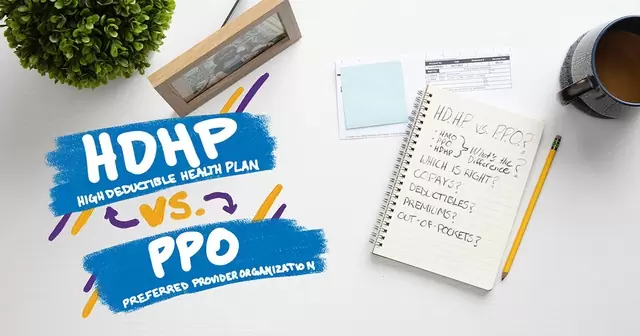Last updated on April 22nd, 2024 at 09:22 am
In today’s complex healthcare landscape, selecting the right health insurance plan can be a daunting task. Among the various options available, two popular choices are High Deductible Health Plans (HDHPs) and Preferred Provider Organization (PPO) plans. Each comes with its own set of advantages and disadvantages, making it crucial for individuals and families to understand the differences between them to make an informed decision.

In this comprehensive blog article, we will delve into the world of HDHPs and PPOs i.e High Deductible Health Plan vs PPO: Understanding the Differences and Choosing the Right Option, exploring their key features, pros and cons, cost implications, and considerations to help you choose the plan that best suits your needs and budget.
1. Understanding High Deductible Health Plans (HDHPs)
A High Deductible Health Plan (HDHP) is a type of health insurance plan with higher deductibles and lower premiums compared to traditional health plans. The defining characteristic of an HDHP is its high deductible, which is the amount you must pay out of pocket for covered medical expenses before the insurance kicks in.

Key Features of HDHPs:
- High Deductibles: HDHPs have significantly higher deductibles than traditional health plans. The deductible for an individual typically ranges from $1,500 to $6,000, while family deductibles can be even higher.
- Lower Premiums: To offset the higher deductibles, HDHPs generally have lower monthly premiums compared to traditional plans. This means you pay less upfront each month for insurance coverage.
- Health Savings Account (HSA) Eligibility: HDHPs often allow individuals to open a Health Savings Account (HSA), a tax-advantaged savings account designed to help you save for medical expenses. Contributions to an HSA are tax-deductible, and withdrawals for qualified medical expenses are tax-free.
- Preventive Services: Despite the high deductible, HDHPs typically cover preventive services, such as annual check-ups, vaccinations, and screenings, without requiring you to meet the deductible first.
- Out-of-Pocket Maximum: HDHPs usually have an out-of-pocket maximum, which limits the total amount you’ll have to pay for covered services during the plan year. Once you reach this limit, the insurance company covers all eligible expenses.
Pros of HDHPs:
- Lower Monthly Premiums: HDHPs can be a cost-effective option for individuals who are relatively healthy or don’t anticipate needing frequent medical services. The lower monthly premiums can save you money on a regular basis.
- Health Savings Account Benefits: The ability to open an HSA can be advantageous for those who want to save for future medical expenses and enjoy tax benefits on contributions.
- Consumer Control: HDHPs may encourage consumers to be more mindful of their healthcare expenses and make informed choices, as they often have a higher financial responsibility upfront.
Cons of HDHPs:
- Higher Out-of-Pocket Costs: The major drawback of HDHPs is the high deductible, which means you’ll need to pay a substantial amount out of pocket before your insurance starts covering costs.
- Limited Coverage before Deductible: Except for preventive services, most medical expenses won’t be covered until you’ve met the deductible, which can be burdensome for those with ongoing medical needs.
- Risks for Low-Income Individuals: For individuals with limited financial resources, the high deductible can be a significant barrier to accessing necessary healthcare services.
2. Exploring Preferred Provider Organization (PPO) Plans
A Preferred Provider Organization (PPO) plan is a type of managed care health insurance plan that offers a network of preferred healthcare providers. PPO plans provide more flexibility and a broader range of coverage compared to HDHPs but typically come with higher monthly premiums.

Key Features of PPO Plans:
- Provider Network: PPO plans have a network of preferred healthcare providers, including hospitals, doctors, and specialists. You have the option to choose healthcare services both within and outside the network.
- Lower Out-of-Pocket Costs within Network: If you seek medical care from in-network providers, you’ll generally pay lower out-of-pocket costs, such as copayments and coinsurance.
- No Referrals Required: PPO plans do not require you to obtain a referral from a primary care physician to see a specialist. You can seek specialized care directly from an in-network specialist.
- Higher Premiums: Compared to HDHPs, PPO plans usually come with higher monthly premiums, meaning you pay more each month for insurance coverage.
- Out-of-Network Coverage: PPO plans do offer coverage for out-of-network providers, but the cost-sharing is higher compared to in-network care. You’ll likely have to pay a larger percentage of the total cost.
Pros of PPO Plans:
- Flexibility in Choosing Providers: PPO plans offer the flexibility to see any healthcare provider, whether they are in-network or out-of-network, without requiring a referral.
- Lower Cost-Sharing within Network: Seeking care from in-network providers can lead to lower out-of-pocket costs, making it easier to budget for medical expenses.
- Suitable for Individuals with Specific Medical Needs: PPO plans can be ideal for individuals with specific medical conditions or who require regular visits to specialists, as they offer access to a broader network of providers.
Cons of PPO Plans:
- Higher Premiums: The higher monthly premiums of PPO plans can be a significant drawback for individuals looking to save on insurance costs.
- Out-of-Network Costs: Utilizing out-of-network providers can result in significantly higher costs due to higher deductibles, coinsurance, and copayments.
- Provider Networks Can Change: The providers within a PPO network can change over time, so it’s essential to regularly check if your preferred healthcare professionals are still in-network.
3. Cost Implications: Comparing HDHPs and PPO Plans (High Deductible Health Plan vs PPO)
When choosing between an HDHP and a PPO plan, understanding the cost implications is vital to making an informed decision.

1. Premiums: HDHPs typically have lower monthly premiums than PPO plans. This makes HDHPs more attractive to individuals who want to save on their monthly expenses.
2. Deductibles: HDHPs have higher deductibles compared to PPO plans. If you don’t anticipate significant medical expenses and are generally healthy, an HDHP could save you money in the long run.
3. Out-of-Pocket Costs: PPO plans generally have lower out-of-pocket costs within their network. If you prefer a wider choice of healthcare providers and are willing to pay higher premiums, a PPO might be more suitable.
4. Health Savings Account (HSA) Contributions: If you choose an HDHP and are eligible for an HSA, you can make tax-deductible contributions to the account, providing additional savings for future medical expenses.
5. Risk Tolerance: Assess your risk tolerance and financial capabilities. HDHPs can expose you to higher costs initially, while PPO plans to provide more predictable expenses but higher monthly premiums.
4. Considerations for Choosing the Right Plan (High Deductible Health Plan vs PPO)
When deciding between an HDHP and a PPO plan, several factors should be taken into account:
1. Health Condition and Medical Needs: Evaluate your health condition and anticipated medical needs for the upcoming year. If you have ongoing medical requirements or expect significant expenses, a PPO plan might be more appropriate. On the other hand, if you are relatively healthy and require minimal medical attention, an HDHP could be a cost-effective option.
2. Budget and Financial Situation: Consider your monthly budget and overall financial situation. If you can afford higher monthly premiums and prefer lower out-of-pocket costs when seeking care, a PPO plan may be the better choice. However, if you want to save on monthly premiums and are comfortable taking on higher initial costs for medical services, an HDHP might suit you better.
3. Access to Healthcare Providers: Check the provider networks of both the HDHP and PPO plans you are considering. Ensure that your preferred doctors, specialists, and hospitals are included in the network. If you have specific healthcare needs or an established relationship with certain providers, this could influence your decision.
4. Health Savings Account (HSA) Benefits: If you choose an HDHP, consider the potential benefits of an HSA. An HSA allows you to save for medical expenses with pre-tax dollars, providing a valuable financial tool for healthcare planning.
5. Family Considerations: If you’re selecting a plan for your family, take into account the health needs of each family member and the potential impact on your overall budget. A PPO plan may provide more comprehensive coverage for family members with specific medical needs, but it may come with higher costs.
6. Employer Offerings: If your health insurance options are provided through your employer, carefully review the plans available to you. Employers may offer various options, and they might contribute to an HSA for HDHPs or subsidize premiums for PPO plans, which could influence your decision.
5. Making the Decision and Taking Charge of Your Health (High Deductible Health Plan vs PPO)
Selecting the right health insurance plan is an essential decision that can have a significant impact on your financial well-being and access to healthcare. By understanding the key differences between High Deductible Health Plans (HDHPs) and Preferred Provider Organization (PPO) plans, evaluating your health needs, and considering your budget, you can make an informed choice that aligns with your unique circumstances.
Keep in mind that healthcare needs can change over time, and what might be the best plan for you now may not be the most suitable option in the future. Regularly reevaluate your insurance needs, and if circumstances change, don’t hesitate to switch to a plan that better fits your current situation.
Above all, remember that health insurance is a vital tool in maintaining your well-being and accessing necessary medical care. Take charge of your health by staying informed about your insurance coverage and making use of preventive services to lead a healthy and fulfilling life.
Disclaimer: The information provided in this article is for general informational purposes only and should not be considered as professional advice. Please consult a qualified insurance expert or healthcare professional for personalized guidance on selecting the most appropriate health insurance plan for your individual needs.
